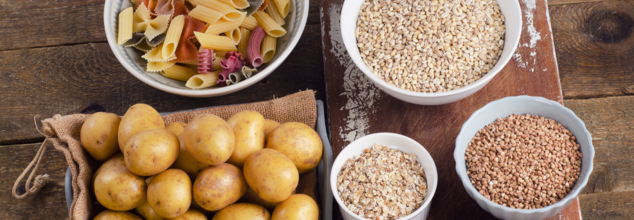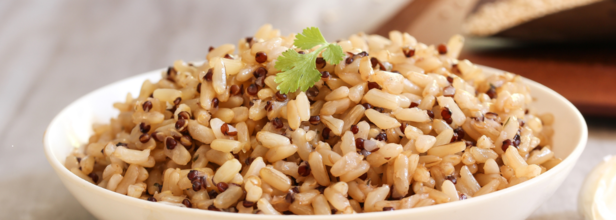
These Healthy Carbs Can Help You Lower Your Cholesterol
Many people believe that one of the biggest enemies of health that is present in their foods is carbohydrates. They avoid all kinds of carbs whether they are natural or processed. However, this nutrient is essential for our body and helps us generate energy for daily activities.
Some popular carbs are foods like French fries and pizzas. These are unhealthy and should be avoided as much as possible. Refined carbs like this can contribute to high cholesterol. Which in turn can affect your heart health.
However, there is a whole other category of carbohydrates that can be surprisingly healthy. In fact, certain carbs possess properties that can positively impact elevated cholesterol levels, potentially lowering them and offering your heart valuable protection. Remember, balance is key. Instead of drastic dietary changes, incorporating a variety of these beneficial carbs into your daily meals and snacks is the most sustainable approach
Brown Rice
According to the Brown University Health, brown rice is a healthy whole grain packed with good stuff like fiber, vitamins, and minerals. Eating whole grains is linked to a healthier heart and can lower "bad" cholesterol. The fiber in brown rice helps stop your body from absorbing too much cholesterol. Plus, it has special things that can lower your overall cholesterol and even help your blood vessels stay healthy.
Purple Potatoes
These colorful potatoes have special things called anthocyanins, which give them their purple color. According to Biomedical and Pharmacology Journal, these can help your body in many ways, including improving cholesterol levels and keeping your blood vessels healthy. Purple potatoes also have a type of fiber called resistant starch. This fiber isn't fully digested and helps prevent your body from absorbing cholesterol. It can even help lower other unhealthy fats in your blood.
Kiwi
Kiwi is a tasty fruit that's great for managing cholesterol. It's full of soluble fiber, which helps trap cholesterol and move it out of your body. This type of fiber stops cholesterol from getting into your bloodstream. Kiwi might also help lower your "bad" cholesterol. It has lots of vitamin C and other good things that can reduce swelling and protect your heart. Plus, it helps your body digest food better, which can also help control cholesterol.
Oats
According to Mayo Clinic, oatmeal is a super healthy food for your heart and can even lower cholesterol. It has lots of soluble fiber, which works like a cleaner, grabbing onto cholesterol and taking it out of your body. Eating oatmeal regularly can really help bring down your "bad" cholesterol levels. Just make sure to choose plain oats instead of the sugary kinds.
Beets
According to the University of Illinois Urbana, beets are a healthy vegetable that might help lower your cholesterol. They're low in fat and calories but have a good amount of fiber. This fiber can help you feel full and can also help lower cholesterol by removing fat from your body. Beets also have special things that can fight swelling, which is linked to higher cholesterol. Drinking beet juice can also be helpful for your cholesterol levels.
Oranges
Havard Health explains that oranges are known for vitamin C, but they also help lower cholesterol. They have soluble fiber, which forms a gel that binds to cholesterol in your body and stops it from being absorbed. Oranges also have plant sterols that compete with cholesterol, so less of it gets into your blood.
Chickpeas
Chickpeas are a great food if you're watching your cholesterol. WebMD explains that they're full of soluble fiber, which helps lower "bad" cholesterol. This fiber works by sticking to cholesterol in your gut and preventing it from getting into your bloodstream. Eating more chickpeas can really make a difference for your cholesterol and heart health.

Credits: Canva
Is Brown Rice Really The Healthier Alternative?
When it comes to rice, many of us want to leave it but are unable to for it being staple to our diet. However, often, we have been told to switch to brown rice, for it is a better alternative, a healthier one than the white rice. It is less processed, rich in fiber, and packed with nutrients. However, a recent study from Michigan State University, published in the journal Risk Analysis, titled: Arsenic content and exposure in brown rice compared to white rice in the United States by Christian Kelly Scott and Felicia Wu, suggested that food safety also needs to be part of the conversation when it comes to brown rice. It is especially important when it comes to its arsenic levels.
What Did The Study Find?
Published in the journal Risk Analysis, the study found that brown rice contains more arsenic than white rice, especially in U.S. populations. Arsenic is a naturally occurring element found in soil and water, but it can be harmful when consumed in high amounts over time.
Researchers found that, on average, brown rice had higher levels of inorganic arsenic—a more toxic form—compared to white rice. This could pose potential health risks, particularly for children under the age of five.
Why Does Rice Contain Arsenic?
Rice is different from other grains because it absorbs more arsenic from the soil. That’s mainly because it’s often grown in flooded fields, where waterlogged soil allows arsenic to be taken up more easily by the plant.
Compared to other cereal grains, rice can take in nearly 10 times more arsenic. And since brown rice keeps its outer layers (which white rice loses during processing), it holds more of the arsenic absorbed from the environment.
Who Is Most at Risk?
The average adult probably doesn’t eat enough brown rice for arsenic to be a serious concern. But children, especially those under five, are more vulnerable. That’s because they tend to eat more food in proportion to their body weight.
Certain communities, like Asian immigrant populations and families dealing with food insecurity, may also face higher exposure if rice is a staple part of their daily diet.
Regional Differences in Arsenic Levels
The study also found that arsenic levels vary depending on where the rice is grown. In U.S.-grown rice, about 48% of arsenic in brown rice was the toxic inorganic kind, compared to 33% in white rice. In rice grown outside the U.S., those numbers were even higher—65% for brown rice and 53% for white.
Should You Stop Eating Brown Rice?
Not necessarily. The study’s lead author, Professor Felicia Wu, says the goal isn’t to scare people away from brown rice. It’s about understanding the trade-offs.
Brown rice has clear health benefits: it’s high in fiber, protein, and niacin. But food choices should consider both nutrition and safety. Wu emphasized that it would take very large amounts of brown rice eaten daily over many years for arsenic to pose a long-term health risk.
Looking Ahead
The U.S. Food and Drug Administration (FDA) is already working on setting safety limits for arsenic in food through its “Closer to Zero” initiative. This could lead to new guidelines that help people make more informed food choices.
Until then, balance is key. Switching between different grains—like oats, quinoa, or barley—can reduce overall arsenic intake while keeping meals healthy and diverse.

Credits: Canva
Healthy vs Unhealthy Fats: All That You Need To Know
For years, fat has been blamed for poor health. However, the truth is that you body needs fat. So, why do we hate fat so much? The key is actually in knowing which fat helps you and which ones harm.
So, here we have a guide for you that will help you understand the fats your body needs:
What Are Fats?
They are also called lipids. They are made of fatty acids and glycerol. They help your body make hormones, absorb nutrients, and keep cells healthy. The three main types of fats are:
- Saturated Fats: They are solid at room temperature and are found in things like butter or red meat.
- Unsaturated Fats: They are liquid at room temperature, mainly found in oils, nuts, and fish. They are also categorized as monounsaturated and polyunsaturated.
- Trans Fats: They are artificial fats which are found in processed foods. These are the most harmful fats and must be avoided.
Monounsaturated Fats (MUFAs)
They are heart healthy fats that can actually help you lower bad cholesterol. They are mainly found in olive oil, avocados, almonds, cashews, and peanuts. It helps lower the risk of heart disease, helps with a better blood sugar control, and reduces inflammation.
Polyunsaturated Fats (PUFAs)
These include the omega-3 and omega-6 fatty acids, which are essential for your body, but your body cannot make it on its own. These can be found in various sources. For omega-3 fatty acids, consume fatty fish like salmon or sardines, or you can have flaxseeds, chia seeds, and walnuts.
- Omega-6 fatty acids are found in vegetable oils like sunflower or safflower, and in soyabeans, seeds, and poultry.
- They can support brain function, fight inflammation, and keep your heart and skin healthy.
Which Fats Are Not That Great For You?
Trans Fats
These are artificial fats made to extend shelf life. They’re the worst type for your health.
Found in:
- Packaged snacks
- Fried fast food
- Some margarines and baked goods
- Raise bad cholesterol (LDL)
- Lower good cholesterol (HDL)
- Increased risk of heart disease and type 2 diabetes
Saturated Fats
These aren't as bad as once thought, but too much may still be risky for some people.Found in:
- Butter, cheese, ghee
- Red meat
- Coconut oil, palm oil
Tips:
- Replace with healthy fats when possible
- Try not to go overboard—moderation matters
- Dairy-based saturated fats may be less harmful than processed meats
Why Fats Matter
Brain Health – DHA (a type of omega-3) is key for memory and brain function.
Inflammation – Omega-3s calm it down; too much omega-6 or trans fat can make it worse.
Diabetes Risk – Healthy fats can improve insulin sensitivity and protect your heart.
How Different Diets Handle Fats
- Mediterranean Diet – Full of olive oil, fish, and nuts. A great example of healthy fat use.
- Keto Diet – High in fat, but quality matters. Choose good fats, skip processed meats.
- Vegan/Vegetarian Diets – Include plant-based fats like nuts, seeds, and avocados. Algae-based omega-3 supplements can help too.
What is important to understand is that fat is not your enemy. It is rather an essential part of your healthy diet. The importance is that you focus on the right kind of fat.

Credits: Canva
How Much Sugar Is Too Much Sugar?
Sugar is one of the most controversial ingredients in modern diets. Everyone is talking about it. How much to take? To consume it or not? How can one limit it? But sadly, it is everywhere. It is in your cereals, in your sauces and in your so called "health bars". However, it is important to understand that not all sugar is the same. The reality is different from blanket warnings. So, to make it easier for you, here is a break down of what sugar really is and how it affects your body.
What Is Sugar?
It is a carbohydrate that gives foods its sweet taste. It also exists in many forms, natural and as added ingredients.
Naturally occurring sugars include fructose which are present in fruits; lactose, which are present in dairy; maltose, which are present in sprouting grains; and glucose, which is body's go-to fuel and found in fruits, and is also created during digestion.
Whereas, added sugars are he one that comes after processing. They are called sucrose, or table sugar, high-fructose or corn syrup, honey agave nectar, maple syrup, and coconut sugar.
While your body ultimately breaks down all kinds of sugars into glucose or fructose, the source and accompanying nutrients, which could be fiber or fat may impact on how it is being absorbed in your body.
Why Too Much Sugar Could Be A Problem?
High sugar intake can lead to reduction in insulin sensitivity and also increase the risk of type 2 diabetes. It can also promote fat buildup in the liver. Sugary foods also lack fiber or protein, so you are more likely to overeat. It could also feed oral bacteria and contribute to cavities.
However, not all sugars are equally harmful.
How Much Sugar Can You Eat?
As per the World Health Organization (WHO), you must keep your sugar under 10% of your total calories. The ideal limit is 5%, which is around 6 tsp of sugar in total.
As per the American Heart Association, men can have 9 tsp of sugar, while women can have 6 tsp of sugar.
As per the US Dietary Guidelines, sugar must be kept under 10% of your daily calories, which is about 50g in a 2,000 calorie diet.
However, in reality, an average American consumes around 77g of sugar, way above the limit.
What All Has Added Sugar In It?
Added sugar isn’t just in desserts. It shows up in:
- Flavored yogurts (15–25g/serving)
- Pasta sauces (up to 12g/half-cup)
- Breakfast cereals and granola (10–15g/serving)
- Salad dressings and protein bars
To manage your intake:
- Read labels for “added sugars”
- Learn sugar’s many names (like dextrose or maltose)
- Choose whole, unprocessed foods
- Use cinnamon or fruit as natural sweeteners
What you must keep in mind is that one size does not fit all. Athletes may benefit from some quick-digesting sugars during or after exercise. Whereas children are more sensitive to sugar's effects and early eating habits. People with diabetes or metabolic conditions must also stay careful and monitor their sugar consumption.
Sugar isn’t evil—it’s context that matters. Focus on reducing added sugars, not cutting all sweet foods out. Occasional treats are fine if your overall diet is nutritious. By staying informed, you can enjoy sweetness without compromising your health.
© 2024 Bennett, Coleman & Company Limited

